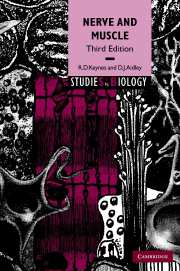Book contents
- Frontmatter
- Contents
- Preface
- Publishers note
- 1 Structural organization of the nervous system
- 2 Resting and action potentials
- 3 The ionic permeability of the nerve membrane
- 4 Membrane permeability changes during excitation
- 5 Voltage-gated ion channels
- 6 Cable theory and saltatory conduction
- 7 Neuromuscular transmission
- 8 Synaptic transmission in the nervous system
- 9 Skeletal muscles
- 10 The mechanism of contraction in skeletal muscle
- 11 Non-skeletal muscles
- Further reading
- References
- Index
10 - The mechanism of contraction in skeletal muscle
Published online by Cambridge University Press: 05 June 2012
- Frontmatter
- Contents
- Preface
- Publishers note
- 1 Structural organization of the nervous system
- 2 Resting and action potentials
- 3 The ionic permeability of the nerve membrane
- 4 Membrane permeability changes during excitation
- 5 Voltage-gated ion channels
- 6 Cable theory and saltatory conduction
- 7 Neuromuscular transmission
- 8 Synaptic transmission in the nervous system
- 9 Skeletal muscles
- 10 The mechanism of contraction in skeletal muscle
- 11 Non-skeletal muscles
- Further reading
- References
- Index
Summary
In the previous chapter we examined some of the properties of skeletal muscles without giving much consideration to the mechanisms of the contraction process. It is as if we had investigated the properties of a motor vehicle by measuring its top speed, its fuel consumption, and so on, without finding out how the engine works. Now it is time to look under the bonnet.
Excitation–contraction coupling
The way in which the muscle cell is excited has been described in Chapter 7: an all-or-nothing action potential sweeps along the whole length of the fibre. This is followed by contraction, and the process linking the two events is called the excitation–contraction coupling process. The question we have to answer is: how does the action potential cause contraction?
Depolarization of the cell membrane
When muscle fibres are immersed in a solution containing a high concentration of potassium ions, they undergo a relatively prolonged contraction called a potassium contracture. The tension produced is related to the potassium concentration in a sigmoidal way as is shown in Fig. 10.1. The membrane potential is of course reduced under these conditions (see Chapter 3), so it seems that depolarization is an adequate stimulus for contraction. Normally this depolarization occurs during the propagated action potential.
- Type
- Chapter
- Information
- Nerve and Muscle , pp. 136 - 155Publisher: Cambridge University PressPrint publication year: 2001

